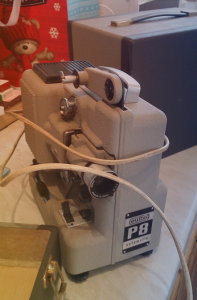Gary Critcher
I have this Eumig P8 projector. I’m pretty sure it’s in working order.
(Click on the picture below to see a larger or clearer version of this picture:
Click the “X” button (top right) to close the newly opened picture.)

Alan Stokes
I haven’t seen one of these for a long time. I had a version of the P8 which had capstans and rollers on the side to ‘synchronise’ a ¼” tape running at 3¾ i.p.s. It behaved (or not) rather like a sepmag track in Telecine. You added ‘start’ marks on the standard 8mm film and the ¼”. Then, I think you set the projector to ‘run’ but it didn’t actually run until the ¼” started. The projector then wowed, not unlike a sepmag, until it had reached the speed to match. The speed of the projector was then adjusted by a control arm around which the ¼” was laced. It was attached to a speed controller inside the P8. It could be troublesome if you fired of the ¼” without having put the projector into standby first. The control arm dropped and tape started spilling all over the floor.
Creating the sound track was fun! You had no ‘rock-n-roll’ to help. I used to run it through the projector, in record, to create a click at every cut in the film. I then worked with a shot list, viewing in the film editor if necessary.
Patrick Heigham
Sounds very similar to how I put together my illicit 8mm film of the Black & White Minstrels. The projector system was a Bauer T10R which had an electrical connection to a tape driven capstan standing next to the tape machine. ( I successfully gaffer taped it to a TR90 for a screening in the 6th floor hospitality suite!). It would handle a tape at 7.5 ips with a larger capstan. To edit the material, I ran a clear film, bleached of emulsion, and dabbed at it with a chinagraph, against a feed sprocket, where I needed a musical cut. The separation between the spocket and gate was therefore consistent. Having established where the picture started and stopped shot by shot, then this was matched to my chinagraph ‘cutting print’! Sadly no-one made an 8mm Pic-Sync. There was an 8mm model of the Siemens 16mm double head, but unaffordable. I wondered about having a 16mm blow-up done, but as computer editing came in, I realised that I could correct some of the sync drift (clockwork camera!), but thought, No, that’s how I made it – I’m not going to fiddle with it.
It’s now been transferred to DVD, via re-photographing a small projected picture with a Sony Betacam 400, with a shutter/frame speed control, reducing the inevitable flicker and illumination pulsing which is evident when trying to copy a cine film at 16fps with electronic 25fps! There is an outfit in Cheshire which offers frame by frame scanning, with constant run, no intermittent, but I haven’t yet tried them.
I would be prepared to send a DVD copy to any Tech-ops people if they would like to wallow in the nostalgia of the TVT in the early 1960’s and the leggy lovelies of the TV Toppers. (TV was B/W, but the 8mm is colour!). Provided no-one flings it to You-Tube! A clip somehow found its way there and Bernie kindly had it taken down.
Here is a PDF document of the story behind the film.
Click on Download PDF to see the PDF in an alternative viewer: this allows you to print or save the complete PDF document, and often makes the document easier to read.
To return to this page, use your browser’s Go Back One Page button.
++++++++++++++++++++++++++++
++++++++++++++++++++++++++++



